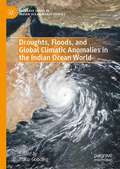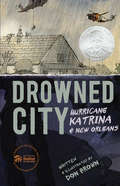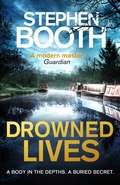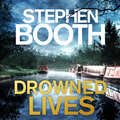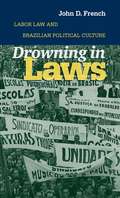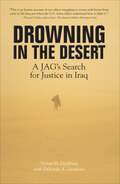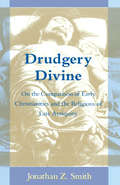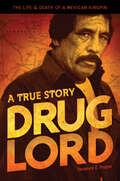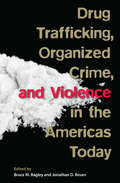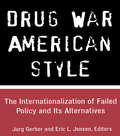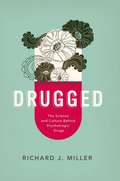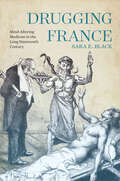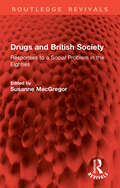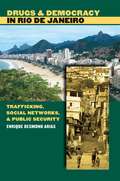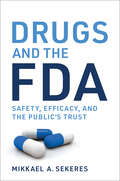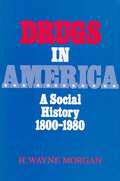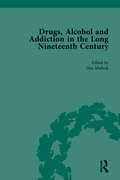- Table View
- List View
Droughts, Floods, and Global Climatic Anomalies in the Indian Ocean World (Palgrave Series in Indian Ocean World Studies)
by Philip GoodingThis book explores histories of droughts and floods in the Indian Ocean World, and their connections to broader global climatic anomalies. It deploys an interdisciplinary approach rooted in the emerging field of climate history to investigate the multifaceted effects of global climatic anomalies on regions affected by the Indian Ocean Monsoon System – regularly conceived of as the macro-region’s ‘deep structure.’ Case studies explore how droughts and floods related to anomalous climatic conditions have historically affected states, societies, and ecologies across the Indian Ocean World, including in relation to food security, epidemic diseases, political (in)stability, economic change, infrastructural development, colonialism, capitalism, and scientific knowledge. Tracing longue durée patterns from the twelfth to the early twentieth centuries, this book makes a significant contribution to our understanding of global climatic events and their effects on the Indian Ocean World. It highlights essential historical case studies for contextualizing the potential effects of global warming on the macro-region in the present and future.
Drowned City: Hurricane Katrina and New Orleans
by Don BrownOn August 29, 2005, Hurricane Katrina's monstrous winds and surging water overwhelmed the protective levees around low-lying New Orleans, Louisiana. Eighty percent of the city flooded, in some places under twenty feet of water. Property damages across the Gulf Coast topped $100 billion. One thousand eight hundred and thirty-three people lost their lives. The riveting tale of this historic storm and the drowning of an American city is one of selflessness, heroism, and courage—and also of incompetence, racism, and criminality. Don Brown’s kinetic art and as-it-happens narrative capture both the tragedy and triumph of one of the worst natural disasters in American history. A portion of the proceeds from this book has been donated to Habitat for Humanity New Orleans. <P><P><i>Advisory: Bookshare has learned that this book offers only partial accessibility. We have kept it in the collection because it is useful for some of our members. Benetech is actively working on projects to improve accessibility issues such as these.</i>
Drowned Lives
by Stephen BoothSet in and around the dark, misty canals of Lichfield, Stephen Booth's incredible new novel is awash with mystery.When council officer Chris Buckley is approached by an odd old man demanding help in healing a decades-old family rift, he sends the stranger away.But then the old man is murdered, and the police arrive on the Chris's doorstep asking questions to which he has no answers.As Chris begins to look into the circumstances of the murder, he uncovers a deadly secret in the silt and mud of the local canals that he'll realise was better kept buried.PRAISE FOR STEPHEN BOOTH'Makes high summer as terrifying as midwinter'Val McDermid'A modern master'Guardian'Crime writing of the finest quality'Daily Mail'Ingenious plotting and richly atmospheric'Reginald Hill'A first-rate mystery'Sunday Telegraph
Drowned Lives
by Stephen BoothSet in and around the dark, misty canals of Lichfield, Stephen Booth's incredible new novel is awash with mystery.When council officer Chris Buckley is approached by an odd old man demanding help in healing a decades-old family rift, he sends the stranger away.But then the old man is murdered, and the police arrive on the Chris's doorstep asking questions to which he has no answers.As Chris begins to look into the circumstances of the murder, he uncovers a deadly secret in the silt and mud of the local canals that he'll realise was better kept buried.PRAISE FOR STEPHEN BOOTH'Makes high summer as terrifying as midwinter'Val McDermid'A modern master'Guardian'Crime writing of the finest quality'Daily Mail'Ingenious plotting and richly atmospheric'Reginald Hill'A first-rate mystery'Sunday Telegraph
Drowned Lives
by Stephen BoothSet in and around the dark, misty canals of Lichfield, Stephen Booth's incredible new novel is awash with mystery.When council officer Chris Buckley is approached by an odd old man demanding help in healing a decades-old family rift, he sends the stranger away.But then the old man is murdered, and the police arrive on the Chris's doorstep asking questions to which he has no answers.As Chris begins to look into the circumstances of the murder, he uncovers a deadly secret in the silt and mud of the local canals that he'll realise was better kept buried.PRAISE FOR STEPHEN BOOTH'Makes high summer as terrifying as midwinter'Val McDermid'A modern master'Guardian'Crime writing of the finest quality'Daily Mail'Ingenious plotting and richly atmospheric'Reginald Hill'A first-rate mystery'Sunday Telegraph
Drowning Ruth
by Christina SchwarzDeftly written and emotionally powerful, Drowning Ruth is a stunning portrait of the ties that bind sisters together and the forces that tear them apart, of the dangers of keeping secrets and the explosive repercussions when they are exposed. A mesmerizing and achingly beautiful debut.Winter, 1919. Amanda Starkey spends her days nursing soldiers wounded in the Great War. Finding herself suddenly overwhelmed, she flees Milwaukee and retreats to her family's farm on Nagawaukee Lake, seeking comfort with her younger sister, Mathilda, and three-year-old niece, Ruth. But very soon, Amanda comes to see that her old home is no refuge--she has carried her troubles with her. On one terrible night almost a year later, Amanda loses nearly everything that is dearest to her when her sister mysteriously disappears and is later found drowned beneath the ice that covers the lake. When Mathilda's husband comes home from the war, wounded and troubled himself, he finds that Amanda has taken charge of Ruth and the farm, assuming her responsibility with a frightening intensity. Wry and guarded, Amanda tells the story of her family in careful doses, as anxious to hide from herself as from us the secrets of her own past and of that night.Ruth, haunted by her own memory of that fateful night, grows up under the watchful eye of her prickly and possessive aunt and gradually becomes aware of the odd events of her childhood. As she tells her own story with increasing clarity, she reveals the mounting toll that her aunt's secrets exact from her family and everyone around her, until the heartrending truth is uncovered.Guiding us through the lives of the Starkey women, Christina Schwarz's first novel shows her compassion and a unique understanding of the American landscape and the people who live on it.From the Hardcover edition.
Drowning Ruth (Oprah's Book Club): The stunning psychological drama you will never forget
by Christina SchwarzNo. 1 New York Times bestseller: 'Powerful... Suspenseful... chilling' New York TimesChristina Schwarz's bestselling novel DROWNING RUTH is a powerful and shocking psychological drama, for everyone who loved THE LIGHT BETWEEN OCEANS or THE TENDERNESS OF WOLVES. At the close of World War One, Amanda Starkey leaves the city and travels to her family's farm to recover from a broken heart. Instead, she is caught up in a tragedy that will take her sister's life and leave Amanda to raise her niece Ruth. What happened that terrible night when Mattie died? Why does Ruth say she can remember drowning? When the truth is revealed, it is shocking, dramatic, and unforgettable. '[A] gripping psychological thriller' Francine Prose, US Weekly'A mesmerizing first novel about horrifying family secrets' Anita Shreve'Riveting... A very suspenseful tale, one that will keep readers up shivering in [the] night' USA Today
Drowning in Laws
by John D. FrenchSince 1943, the lives of Brazilian working people and their employers have been governed by the Consolidation of Labor Laws (CLT). Seen as the end of an exclusively repressive approach, the CLT was long hailed as one of the world's most advanced bodies of social legislation. In Drowning in Laws, John D. French examines the juridical origins of the CLT and the role it played in the cultural and political formation of the Brazilian working class.Focusing on the relatively open political era known as the Populist Republic of 1945 to 1964, French illustrates the glaring contrast between the generosity of the CLT's legal promises and the meager justice meted out in workplaces, government ministries, and labor courts. He argues that the law, from the outset, was more an ideal than a set of enforceable regulations--there was no intention on the part of leaders and bureaucrats to actually practice what was promised, yet workers seized on the CLT's utopian premises while attacking its systemic flaws. In the end, French says, the labor laws became "real" in the workplace only to the extent that workers struggled to turn the imaginary ideal into reality.
Drowning in the Desert: A JAG's Search for Justice in Iraq
by Vivian H. Gembara Deborah A. GembaraSeveral people are waiting to greet Captain Vivian Gembara when she returns home after a year-long tour of duty in Iraq--her grateful fiancŠ and two officers dispatched from headquarters to retrieve "the file." Certainly not the homecoming she expected, but such is life when you are in the business of soldiers behaving badly. As a lawyer for the U.S. Army, Vivian counsels them, investigates them, and when necessary, prosecutes them. When an Iraqi teenagers body is found floating in the Tigris River and U.S. soldiers are believed to have been involved, she knows she has a case on her hands. What she doesn't realize is just how much that case will reveal about the Armys conduct at war.Drowning in the Desert:A JAG's Search for Justice in Iraq is both a legal thriller and a searing account of the savagery that occurs when commanders place "the fight" above all else.
Drudgery Divine: On The Comparison Of Early Christianities And The Religions Of Late Antiquity
by Jonathan Z. SmithIn this major theoretical and methodological statement on the history of religions, Jonathan Z. Smith shows how convert apologetic agendas can dictate the course of comparative religious studies. As his example, Smith reviews four centuries of scholarship comparing early Christianities with religions of late Antiquity (especially the so-called mystery cults) and shows how this scholarship has been based upon an underlying Protestant-Catholic polemic. The result is a devastating critique of traditional New Testament scholarship, a redescription of early Christianities as religious traditions amenable to comparison, and a milestone in Smith's controversial approach to comparative religious studies. "An important book, and certainly one of the most significant in the career of Jonathan Z. Smith, whom one may venture to call the greatest pathologist in the history of religions. As in many precedent cases, Smith follows a standard procedure: he carefully selects his victim, and then dissects with artistic finesse and unequaled acumen. The operation is always necessary, and a deconstructor of Smith's caliber is hard to find."—Ioan P. Coulianu, Journal of Religion
Drug Diplomacy in the Twentieth Century
by William B. McAllisterDrug Diplomacy is the first comprehensive historical account of the evolution of the global drugs control regime. The book analyzes how the rules and regulations that encompass the drug question came to be framed. By examining the international historical aspects of the issue, the author addresses the many questions surrounding this global problem. Including coverage of substances from heroin and cocaine to morphine, stimulants, hallucinogens and alcohol, Drug Diplomacy addresses: * the historical development of drug laws, drug-control institutions, and attitudes about drugs * international control negotiations and the relationship between the drug question and issues such as trade policy, national security concerns, the Cold War and medical considerations * the reasons why the goal to eliminate drug abuse has been so hard to accomplish.
Drug Discovery in Japan: Investigating the Sources of Innovation
by Sadao NagaokaThis book analyzes the drug-discovery process in Japan, based on detailed case studies of 12 groups of 15 innovative drugs. It covers the first statin in the world up to the recent major breakthrough in cancer therapy, the recent immune checkpoint inhibitor, the scientific discovery for which a 2018 Nobel Prize in Physiology or Medicine was awarded to Prof. Tasuku Honjo, Kyoto University. The book shows the pervasive high uncertainty in drug discovery: frequent occurrences of unexpected difficulties, discontinuations, serendipities, and good luck, significantly because drug discovery starts when the underlying science is incomplete. Thus, there exist dynamic interactions between scientific progress and drug discovery. High uncertainty also makes the value of an entrepreneurial scientist high. Such scientists fill the knowledge gaps by absorbing external scientific progress and by relentless pursuit of possibilities through their own research, often including unauthorized research, to overcome crises. Further, high uncertainty and its resolution significantly characterize the evolution of competition in the drug industry. The patent system promotes innovation under high uncertainty not only by enhancing appropriability of R&D investment but also by facilitating the combination of knowledge and capabilities among different firms through disclosure. Understanding such a process significantly benefits the creation of innovation management and policy practices.
Drug Lord: A True Story
by Charles Bowden Terrence E. Poppa"Drug Lord is the real thing. Raw, immediate, indispensable."-Don Winslow, author of The Power of Dog and California Fire and Life"The [drug smuggling] business goes on, the slaughtered dead pile up, the US agencies continue to ratchet up their budgets, the prisons grow larger and all the real rules of the game are in this book, some kind of masterpiece."-Charles Bowden, from the introduction"Pablo Acosta was a living legend in his Mexican border town of Ojinaga. He smuggled tremendous amounts of drugs into the United States; he survived numerous attempts on his power-and his life-by rivals; and he blessed the town with charity and civic improvements. He was finally slain in 1987 during a raid by Mexican officials with the cooperation of US law enforcement. Poppa has turned out a detailed and exciting book, covering in depth Acosta's life; the other drug factions that battled with him; the village of Ojinaga; and the logistics of the drug operation. The result is a nonfiction account with enough greed, treachery, shoot-outs, and government corruption to fascinate true crime and crime fiction readers alike. Highly recommended."-Library JournalTerrence E. Poppa, an award-winning journalist, was a finalist for a 1987 Pulitzer Prize for his investigations into the connection between crime and government in Mexico. He was featured in Standoff in Mexico, a PBS production about fraudulent elections in Mexico. Due to his unique insights into the world of Mexican drug trafficking, Poppa has been widely interviewed on radio and television, including Larry King Live and The O'Reilly Factor.
Drug Trafficking, Organized Crime, and Violence in the Americas Today
by Jonathan D. Rosen Bruce M. Bagley"An extensive overview of the drug trade in the Americas and its impact on politics, economics, and society throughout the region. . . . Highly recommended."--Choice "A first-rate update on the state of the long-fought hemispheric 'war on drugs.' It is particularly timely, as the perception that the war is lost and needs to be changed has never been stronger in Latin and North America."--Paul Gootenberg, author of Andean Cocaine: The Making of a Global Drug "A must-read volume for policy makers, concerned citizens, and students alike in the current search for new approaches to forty-year-old policies largely considered to have failed."--David Scott Palmer, coauthor of Power, Institutions, and Leadership in War and Peace "A very useful primer for anyone trying to keep up with the ever-evolving relationship between drug enforcement and drug trafficking."--Peter Andreas, author of Smuggler Nation: How Illicit Trade Made America In 1971, Richard Nixon declared a war on drugs. Despite foreign policy efforts and attempts to combat supply lines, the United States has been for decades, and remains today, the largest single consumer market for illicit drugs on the planet. This volume argues that the war on drugs has been ineffective at best and, at worst, has been highly detrimental to many countries. Leading experts in the fields of public health, political science, and national security analyze how U.S. policies have affected the internal dynamics of Mexico, Colombia, Bolivia, Peru, Brazil, Argentina, Central America, and the Caribbean islands. Together, they present a comprehensive overview of the major trends in drug trafficking and organized crime in the early twenty-first century. In addition, the editors and contributors identify emerging issues and propose several policy options to address them. This accessible and expansive volume provides a framework for understanding the limits and liabilities in the U.S.-championed war on drugs throughout the Americas.
Drug War American Style: The Internationalization of Failed Policy and its Alternatives (Current Issues in Criminal Justice #26)
by Jurg Gerber Eric L. JensenThis collection of scholarly essays discusses the internationalization of American drug policy from a variety of perspectives and features articles on Hong Kong, Britain, Australia, Canada, Taiwan, Latin America, the Netherlands and Switzerland.
Drug War Crimes: The Consequences of Prohibition
by Jeffrey MironA balanced and sophisticated analysis of the true costs, benefits, and consequences of enforcing drug prohibition is presented in this book. Miron argues that prohibition's effects on drug use have been modest and that prohibition has numerous side effects, most of them highly undesirable. In particular, prohibition is shown to directly increase violent crime, even in cases where it deters drug use. Miron's analysis leads to a disturbing finding—the more resources given to the fight against drugs, the greater the homicide rate. The costs and benefits of several alternatives to the war on drugs are examined. The conclusion is unequivocal and states that any of the most widely discussed alternatives is likely to be a substantial improvement over current policy.
Drugged: The Science And Culture Behind Psychotropic Drugs
by Richard J. Miller"Morphine," writes Richard J. Miller, "is the most significant chemical substance mankind has ever encountered." So ancient that remains of poppies have been found in Neolithic tombs, it is the most effective drug ever discovered for treating pain. "Whatever advances are made in medicine," Miller adds, "nothing could really be more important than that." And yet, when it comes to mind-altering substances, morphine is only a cc or two in a vast river that flows through human civilization, ranging LSD to a morning cup of tea. In DRUGGED, Miller takes readers on an eye-opening tour of psychotropic drugs, describing the various kinds, how they were discovered and developed, and how they have played multiple roles in virtually every culture. The vast scope of chemicals that cross the blood-brain barrier boggle the very brain they reach: cannabis and cocaine, antipsychotics and antidepressants, alcohol, amphetamines, and Ecstasy-and much more. Literate and wide-ranging, Miller weaves together science and history, telling the story of the undercover theft of 20,000 tea plants from China by a British spy, for example, the European discovery of coffee and chocolate, and how James Wolfgang von Goethe, the famous man of letters, first isolated the alkaloid we now know as caffeine. Miller explains what scientists know-and don't-about the impact of each drug on the brain, down to the details of neurotransmitters and their receptors. He clarifies the differences between morphine and heroin, mescaline and LSD, and other similar substances. Drugged brims with surprises, revealing the fact that antidepressant drugs evolved from the rocket fuel that shot V2 rockets into London during World War II, highlighting the role of hallucinogens in the history of religion, and asking whether Prozac can help depressed cats. Entertaining and authoritative, Drugged is a truly fascinating book.
Drugging France: Mind-Altering Medicine in the Long Nineteenth Century (Intoxicating Histories)
by Sara E. BlackIn the nineteenth century, drug consumption permeated French society to produce a new norm: the chemical enhancement of modern life. French citizens empowered themselves by seeking pharmaceutical relief for their suffering and engaging in self-medication. Doctors and pharmacists, meanwhile, fashioned themselves as gatekeepers to these potent drugs, claiming that their expertise could shield the public from accidental harm. Despite these efforts, the unanticipated phenomenon of addiction laid bare both the embodied nature of the modern self and the inherent instability of the notions of individual free will and responsibility.Drugging France explores the history of mind-altering drugs in medical practice between 1840 and 1920, highlighting the intricate medical histories of opium, morphine, ether, chloroform, cocaine, and hashish. While most drug histories focus on how drugs became regulated and criminalized as dangerous addictive substances, Sara Black instead traces the spread of these drugs through French society, demonstrating how new therapeutic norms and practices of drug consumption transformed the lives of French citizens as they came to expect and even demand pharmaceutical solutions to their pain. Through self-experimentation, doctors developed new knowledge about these drugs, transforming exotic botanical substances and unpredictable chemicals into reliable pharmaceutical commodities that would act on the mind and body to modify pain, sensation, and consciousness.From the pharmacy counter to the boudoir, from the courtroom to the operating theatre, from the battlefield to the birthing chamber, Drugging France explores how everyday encounters with drugs reconfigured how people experienced their own minds and bodies.
Drugs and British Society: Responses to a Social Problem in the Eighties (Routledge Revivals)
by Susanne MacGregorFirst published in 1989, Drugs and British Society (now with a new preface by Susanne MacGregor) provides information on the drugs problem in Britain in the 1980s, based on extensive research and experience, and places it in its international and historical context.The contributors to this book are all experts in this field, and are drawn from a range of disciplines, including epidemiology, sociology, social psychiatry, social policy, anthropology, and history. They share a social rather than a narrowly medical or individualistic perspective on drugs, stressing that policy and practice about drugs must be based not on prejudice, alarm or outdated ideas, but on clear, reliable and detailed evidence and the informed judgements of people who have a thorough understanding of the issues. They explain the problem by referring it to its social and political context, from the level of the local community and local services to the wider national and structural levels.
Drugs and Democracy in Rio de Janeiro
by Enrique Desmond AriasTaking an ethnographic approach to understanding urban violence, Enrique Desmond Arias examines the ongoing problems of crime and police corruption that have led to widespread misery and human rights violations in many of Latin America's new democracies. Employing participant observation and interview research in three favelas (shantytowns) in Rio de Janeiro over a nine-year period, Arias closely considers the social interactions and criminal networks that are at the heart of the challenges to democratic governance in urban Brazil. Much of the violence is the result of highly organized, politically connected drug dealers feeding off of the global cocaine market. Rising crime prompts repressive police tactics, and corruption runs deep in state structures. The rich move to walled communities, and the poor are caught between the criminals and often corrupt officials. Arias argues that public policy change is not enough to stop the vicious cycle of crime and corruption. The challenge, he suggests, is to build new social networks committed to controlling violence locally. Arias also offers comparative insights that apply this analysis to other cities in Brazil and throughout Latin America.
Drugs and the Addiction Aesthetic in Nineteenth-Century Literature (Palgrave Studies in Literature, Science and Medicine)
by Adam ColmanThis book explores the rise of the aesthetic category of addiction in the nineteenth century, a century that saw the development of an established medical sense of drug addiction. Drugs and the Addiction Aesthetic in Nineteenth-Century Literature focuses especially on formal invention—on the uses of literary patterns for intensified, exploratory engagement with unattained possibility—resulting from literary intersections with addiction discourse. Early chapters consider how Romantics such as Thomas De Quincey created, with regard to drug habit, an idea of habitual craving that related to self-experimenting science and literary exploration; later chapters look at Victorians who drew from similar understandings while devising narratives of repetitive investigation. The authors considered include De Quincey, Percy Shelley, Alfred Tennyson, Christina Rossetti, Charles Dickens, Robert Louis Stevenson, and Marie Corelli.
Drugs and the FDA: Safety, Efficacy, and the Public's Trust
by Mikkael A. SekeresHow the FDA was shaped by public health crises and patient advocacy, told against a background of the contentious hearings on the breast cancer drug Avastin.Food and Drug Administration approval for COVID-19 vaccines and the controversial Alzheimer&’s drug Aduhelm made headlines, but few of us know much about how the agency does its work. Why is the FDA the ultimate US authority on a drug&’s safety and efficacy? In Drugs and the FDA, Mikkael Sekeres—a leading oncologist and former chair of the FDA&’s cancer drug advisory committee—tells the story of how the FDA became the most trusted regulatory agency in the world. It took a series of tragedies and health crises, as well as patient advocacy, for the government to take responsibility for ensuring the efficacy and safety of drugs and medical devices. Before the FDA existed, drug makers could hawk any potion, claim treatment of any ailment, and make any promise on a label. But then, throughout the twentieth century, the government was forced to take action when children were poisoned by contaminated diphtheria and smallpox vaccines, an early antibiotic contained antifreeze, a drug prescribed for morning sickness in pregnancy caused babies to be born disfigured, and access to AIDS drugs was limited to a few clinical trials while thousands died. Sekeres describes all these events against the backdrop of the contentious 2011 hearings on the breast cancer drug Avastin, in which he participated as a panel member. The Avastin hearings, he says, put to the test a century of the FDA&’s evolution, demonstrating how its system of checks and balances works—or doesn&’t work.
Drugs in America: A Social History, 1800-1980
by H. Wayne MorganThis book developed out of my general interest in the late nineteenth century. While reading through the popular press in connection with another project, I discovered a great deal of comment on the "opium problem," and on drug use in general. I unearthed several addict memoirs and other unusual sources, and the medical literature proved a gold mine of information. After further research, it seemed to me that a brief general survey of the question with some depth and fresh information was in order, and this book is the result.
Drugs, Alcohol and Addiction in the Long Nineteenth Century: Volume I
by Dan MalleckThis collection captures key themes and issues in the broad history of addiction and vice in the Anglo-American world. Focusing on the long nineteenth-century, the volumes consider how scientific, social, and cultural experiences with drugs, alcohol, addiction, gambling, and prostitution varied around the world. What might be considered vice, or addiction could be interpreted in various ways, through various lenses, and such activities were interpreted differently depending upon the observer: the medical practitioner; the evangelical missionary; the thrill seeking bon-vivant, and the concerned government commissioner, to name but a few. For example, opium addiction in middle class households resulting from medical treatment was judged much differently than Chinese opium smoking by those in poverty or poor living conditions in North American work camps on the west coast, or on the streets of Soho. This collection will assemble key documents representing both the official and general view of these various activities, providing readers with a cross section of interpretations and a solid grounding in the material that shaped policy change, cultural interpretation, and social action.
Drugs, Alcohol and Addiction in the Long Nineteenth Century: Volume II
by Dan MalleckThis collection captures key themes and issues in the broad history of addiction and vice in the Anglo-American world. Focusing on the long nineteenth-century, the volumes consider how scientific, social, and cultural experiences with drugs, alcohol, addiction, gambling, and prostitution varied around the world. What might be considered vice, or addiction could be interpreted in various ways, through various lenses, and such activities were interpreted differently depending upon the observer: the medical practitioner; the evangelical missionary; the thrill seeking bon-vivant, and the concerned government commissioner, to name but a few. For example, opium addiction in middle class households resulting from medical treatment was judged much differently than Chinese opium smoking by those in poverty or poor living conditions in North American work camps on the west coast, or on the streets of Soho. This collection will assemble key documents representing both the official and general view of these various activities, providing readers with a cross section of interpretations and a solid grounding in the material that shaped policy change, cultural interpretation, and social action.
